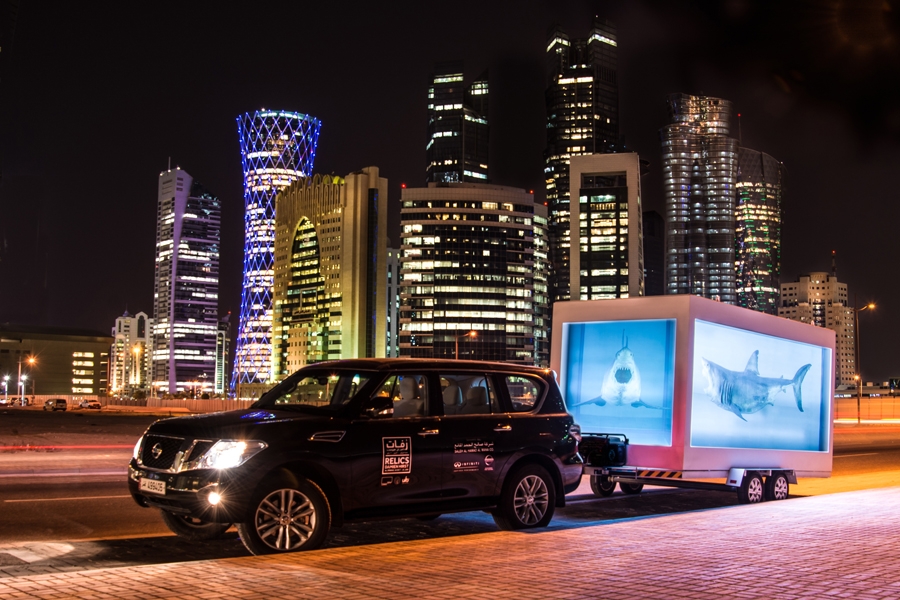Qatar is an anxious place. Some unease stems from simple population imbalance: 85 percent of the nearly two million residents are non-Qatari expatriates, leaving the curiously minority locals to fend off the challenges of a smothered identity. Occasional media flare-ups by incensed columnists rallying to rein in perceived expat excesses – notably Faisal Al-Marzouqi’s Qatar Museums Authority-targeted rants in the Al Arab newspaper in the summer of 2013, which mushroomed on Twitter under the hashtag ‘What’s going on at the QMA?’ – combine with regularly reinforced modesty-minded dresscodes and an increasingly visible aniconic slant to leave foreign residents feeling like they are perpetually transgressing. Looming above it all is ‘Qatar National Vision 2030’, the framework document that will transit the peninsula state away from its finite resources towards a flourishing of human capital. It reads like a must-have list for any globally serious state: world-class healthcare infrastructure, check; environmental preservation, check; diversified local workforce, check. The countdown ticks away even as the country finds itself embroiled on the world stage with the now jeopardised 2022 FIFA World Cup bid and accusations of funding Islamists of an unsavoury ilk. Expressions of soft power abroad abound, undaunted. Qatar is so well known for its deep investment in key Western interests – Harrods and the Shard skyscraper in London, for example; Printemps and Paris Saint-Germain FC across the Channel – that sculptor Richard Serra’s recent East-West/West-East (2014) installation in the Qatari desert could perhaps be read on a deeper level than mere geographical coordinates.
An end-of-an-era atmosphere prevails in Doha. The June 2013 ascension of the new emir, Sheikh Tamim bin Hamad al-Thani, signalled a shift away from past slow-burn, out-of-the-limelight cultural endeavours – his mother, Sheikha Mozah, was instrumental in Qatari education modernisation, while Sheikh Hassan bin Mohamed bin Ali Al-Thani (founder of Mathaf: Arab Museum of Modern Art, and deputy chair of Qatar Museums, as the former Authority is now known) was quietly amassing a motherlode of modern Arab art, long before Sheikha Mayassa’s buying binges and blockbuster spectacle. His trove constitutes the core collections of the Mathaf, yet these are rarely displayed. Sheikh Hassan himself, like Sheikha Mozah, has been eclipsed by Mayassa’s globally publicised collecting practices.
The new emir seems to be shunning soft power for a harder approach at home. The mood is decidedly disciplinarian: police presence has increased, as have closures of nightlife venues serving alcohol. Rumours augur massive layoffs in certain sectors (on the heels of 40 redundancies at the Doha Film Institute earlier this year), while triangulated tensions between the government, the public and Qatar Museums ignite social media. Within this domestic context, there is cause to wonder if contemporary art has not become a liability in the kind of nation-building the emir has in mind. The sheikha’s funding of artists and exhibitions subsequently roped into the Qatar cultural corral – Takashi Murakami at Versailles in 2010 followed by his 2012 exhibition, Murakami-Ego, in Doha; Damien Hirst’s 2012 Tate Modern show, which segued into his 2013 Relics exhibit at Doha’s Al Riwaq Art Space – is locally lacklustre. Much of the so-called daring public art Mayassa has introduced – Adel Abdessemed’s hotly criticised Coup de Tête (2013) immortalising the French footballer Zidane’s inglorious 2006 headbutting of Italian player Marco Materazzi, or Hirst’s weirdly monumental Miraculous Journey (2013) series of 14 bronze statues covering the steps of foetal gestation – have done little to help her cause in the eyes of a local public that is at once confused and conformist.
There is an uneasy hollowness to cultivating public discourse on a diamond-encrusted skull when that same public has no say in social policy or urban investment
“The public is timid,” confides a long-time Doha Arab expat resident and former cultural sector employee. “They are afraid to push the door of a gallery or see a show. Even expats.” While the Hirst retrospective was a benchmark, audience-wise, for Tate, in Doha, organisers resorted to ‘pull’ tactics to generate interest. The world-class marketing rollout consisted of an ersatz shark tank hitched to a 4X4 and towed around town, a succession of higher-order-benefit-touting ads on art appreciation (‘This is not just a diamond encrusted skull’, promises the headline copy) and ‘SharePoints’ set up in shopping malls for potential viewers to register their thoughts on Hirst’s art. Similarly, Serra’s sculpture benefited from a hashtag campaign inviting visitors to complete the sentence ‘I felt…’ with a single word. Rounded up in a word cloud on the website, the result (both ‘big’ and ‘small’ vie for position as the plumpest word) seems far less telling than the very process of canvassing popular opinion in an absolute monarchy. There is an uneasy hollowness to cultivating public discourse on a diamond-encrusted skull when that same public has no say in social policy or urban investment.
Increasingly, though, voices will matter. Insiders tell of a body of work to be featured in the upcoming Jean Nouvel-designed Qatar National Museum – the National Oral History Project. Predicated on the knowledge that much of the nation’s past cultural wealth has been constituted orally, rather than imaged, the project sets out to document this history. Yet as the collection and recording campaign unfolds, one question resounds: whose voice will be heard? Will the voices so keenly solicited in cultural hashtag campaigns be asked to contribute to this institutionalised, lasting narrative?
This article was first published in the November 2014 issue.
